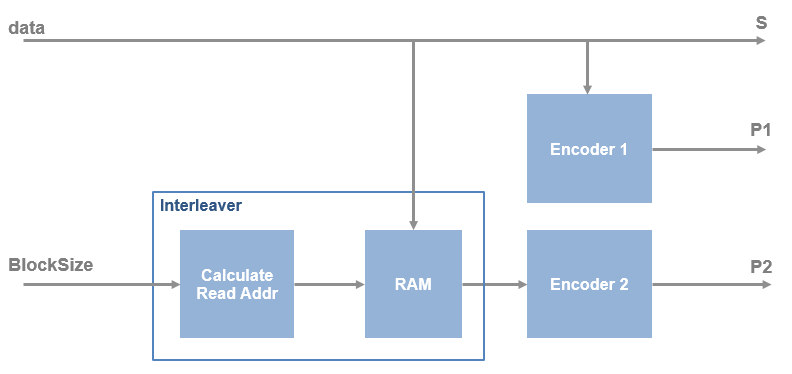LTE Turbo Encoder
Encode binary samples using turbo algorithm
Libraries:
Wireless HDL Toolbox /
Error Detection and Correction
Description
The LTE Turbo Encoder block implements the turbo encoder described by
LTE standard TS 36.212 [1] using an interface
and architecture optimized for HDL code generation and hardware deployment. The encoder
is a parallel concatenated convolutional code (PCCC) with two 8-state constituent
encoders and an internal interleaver. The first encoder operates on the input data
stream, and the second encoder operates on an interleaved version of the input data. The
block terminates each encoder output with independent tail bits. The coding rate is 1/3.
The encoded output bits for each input bit are returned as a 3-by-1 vector, [S
P1 P2]. In this vector, S is the systematic bit, and
P1 and P2 are the parity bits from the two
encoders.
This block uses a
streaming sample interface with a bus for related control signals. This interface enables the
block to operate independently of frame size, and to connect easily with other Wireless HDL Toolbox™ blocks. The block accepts and returns a value representing a single sample, and a
bus containing three control signals. These signals indicate the validity of each sample and the
boundaries of the frame. To convert a matrix into a sample stream and these control signals, use
the Frame To Samples block
or the whdlFramesToSamples
function. For a full description of the interface, see Streaming Sample Interface.
The block can accept new input data after the previous frame is complete. Apply input
frames with at least BlockSize + 16 idle cycles between them. The 16
cycles consists of 12 cycles for pipeline delays in the algorithm, and 4 cycles of tail
bits. This latency does not vary with block size. Or, you can use the output signal
ctrl.end to determine when the block is
ready for new input.
This waveform shows an input frame of 40 samples, with 57 idle cycles between frames.
The input and output ctrl buses are expanded to show the control
signals. start and end show the frame boundaries,
and valid qualifies the data samples. The optional
tail1 and tail2 signals indicate the
cycles when the tail bits from each encoder are valid.

Examples
Ports
Input
Output
Parameters
Tips
You cannot use this block inside an Enabled Subsystem or Resettable Subsystem.
Algorithms
References
[1] 3GPP TS 36.212. "Multiplexing and channel coding." 3rd Generation Partnership Project; Technical Specification Group Radio Access Network; Evolved Universal Terrestrial Radio Access (E-UTRA). URL: https://www.3gpp.org.
Extended Capabilities
Version History
Introduced in R2017b
See Also
Blocks
Functions
lteTurboEncode(LTE Toolbox) |lteTurboDecode(LTE Toolbox) |lteDLSCHInfo(LTE Toolbox)

